

Big data: The next frontier for innovation, competition, and productivity. The amount of data in our world has been exploding, and analyzing large data sets—so-called big data—will become a key basis of competition, underpinning new waves of productivity growth, innovation, and consumer surplus, according to research by MGI and McKinsey's Business Technology Office.
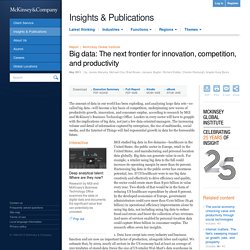
Leaders in every sector will have to grapple with the implications of big data, not just a few data-oriented managers. The increasing volume and detail of information captured by enterprises, the rise of multimedia, social media, and the Internet of Things will fuel exponential growth in data for the foreseeable future. MGI studied big data in five domains—healthcare in the United States, the public sector in Europe, retail in the United States, and manufacturing and personal-location data globally. Big data can generate value in each. For example, a retailer using big data to the full could increase its operating margin by more than 60 percent. 1. 2. Podcast 3. 4. 5. 6. 7.
Big Data's Management Revolution - Erik Brynjolfsson and Andrew McAfee. By Erik Brynjolfsson and Andrew McAfee | 10:05 AM September 11, 2012 Big data has the potential to revolutionize management.

Simply put, because of big data, managers can measure, and hence know, radically more about their businesses, and directly translate that knowledge into improved decision making and performance. Data Changes Everything: Delivering on the Promise of Learning Analytics in Higher Education (EDUCAUSE Review) Ellen Wagner is Executive Director of the WICHE (Western Interstate Commission for Higher Education) Cooperative for Educational Technologies (WCET) and is Partner and Senior Analyst with Sage Road Solutions, LLC.
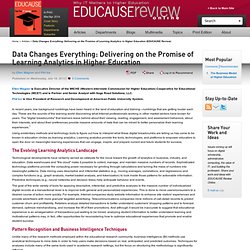
Phil Ice is Vice President of Research and Development at American Public University System. In recent years, low background rumblings have been heard in the land of education and training—rumblings that are getting louder each day. These are the sounds of the learning world discovering what Internet professionals working in other market sectors have known for years: The "digital breadcrumbs" that learners leave behind about their viewing, reading, engagement, and assessment behaviors, about their interests, and about their preferences provide massive amounts of data that can be mined to better personalize their learning experiences.1 The Evolving Learning Analytics Landscape Pattern Recognition and Business Intelligence Techniques Analytics in the Higher Education Enterprise.
Big Data on the College Campus. Data Analytics | Feature Big Data on the College Campus By Bridget McCrea10/10/12 The information age has been both a blessing and a curse for institutions of higher education.

Colleges Awakening to the Opportunities of Data Mining. PAR Framework Project Eyes Student Data Through a 'Multi-Institutional Lens' Predictive Analytics | Interview PAR Framework Project Eyes Student Data Through a 'Multi-Institutional Lens' A Q&A with WCET Executive Director Ellen Wagner By Mary Grush08/28/12 WCET, the WICHE Cooperative for Educational Technologies, has been awarded $2.56 million from the Bill & Melinda Gates Foundation to validate and extend the PAR Framework Project, ongoing research into the use of predictive analytics on a large-scale federated database to support decision making that removes barriers to student success.
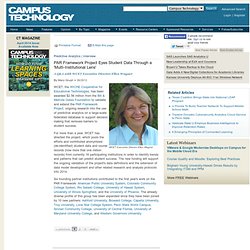
For more than a year, WCET has directed the project, which pools the efforts and contributed anonymized (de-identified) student data and course records (now more that one million records) from currently 16 participating institutions in order to identify trends and patterns that can predict student success. The PAR Framework Proof of Concept: Initial Findings from a Multi-Institutional Analysis of Federated Postsecondary Data. The PAR Framework Proof of Concept: Initial Findings from a Multi-Institutional Analysis of Federated Postsecondary Data Philip Ice, Sebastián Díaz, Karen Swan, Melissa Burgess, Mike Sharkey, Jonathan Sherrill, Daniel R.

Huston, Hae Okimoto Abstract Despite high enrollment numbers, postsecondary completion rates have generally remained unchanged for the past 30 years and half of these students do not attain a degree within six years of initial enrollment. Predictive Analytics Reporting (PAR) Framework. Analytics for Learn. Blackboard Analytics for Learn™ combines the extensive data from Blackboard Learn™ with student and course attributes from your SIS/ERP to create comprehensive reports and dashboards for your students, instructors, staff and leadership.
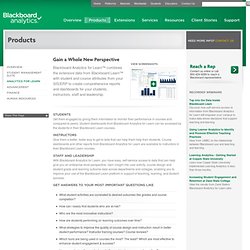
Get them engaged by giving them information to monitor their performance in courses and compared to peers. Student dashboards from Blackboard Analytics for Learn can be accessed by the students in their Blackboard Learn courses. Give them a better, faster way to get to data that can help them help their students. Knowledge Media Institute. Alumni Member Professor of Learning Informatics My work is inspired by the vision and >40 years’ work of pioneer Doug Engelbart: to develop technologies which “augment human intellect”, our “collective capability for coping with complex, urgent problems.”
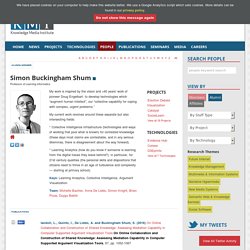
My current work revolves around these separate but also intersecting fields: * Collective Intelligence infrastructure (technologies and ways of working that pool what is known) for contested knowledge (these days most claims are contestable, and in any serious dilemmas, there is disagreement about the way forward). * Learning Analytics (how do you know if someone is learning from the digital traces they leave behind?)
Understanding Learning Analytics and Student Data. Using Analytics to Intervene with Underperforming College Students (Innovative Practice. CourseSmart announces analytics program to measure student engagement. It has never been too hard to spot the student in class who didn’t do the assigned reading -- she’s usually the one in the back, not raising her hand, and avoiding eye contact in hopes of not being called on.
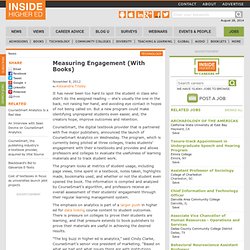
But a new program could make identifying unprepared students even easier, and, the creators hope, improve outcomes and retention. CourseSmart, the digital textbook provider that is partnered with five major publishers, announced the launch of CourseSmart Analytics on Wednesday. The program, which is currently being piloted at three colleges, tracks students’ engagement with their e-textbooks and provides and allows professors and colleges to evaluate the usefulness of learning materials and to track student work.
The program looks at metrics of student usage, including page views, time spent in a textbook, notes taken, highlights made, bookmarks used, and whether or not the student even opened the book. Professors can also evaluate how engaged the class is as a whole.